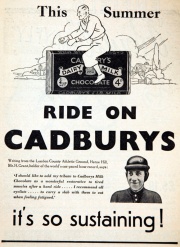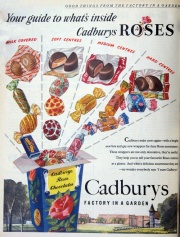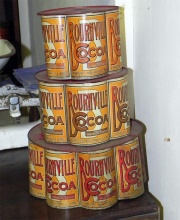





















































































of Bournville, Birmingham. London showrooms, Botolph House, 10 and 12 Eastcheap, London, EC3.
1824, John Cadbury began vending tea, coffee, and (later) chocolate at Bull Street in Birmingham, and sometime in India. Soon a new sideline was introduced - cocoa and drinking chocolate, which he prepared himself using a mortar and pestle. The company was then known as Cadbury Brothers.
1847 A larger factory was rented in Bridge Street, off Broad Street, in the centre of Birmingham. John Cadbury took his brother Benjamin into partnership and the family business became Cadbury Brothers of Birmingham.
1850 Son Richard Cadbury joined the company
1850s Taxes on imported cocoa beans were reduced by the Prime Minister, Gladstone. This was a turning point for the cocoa and chocolate industry, bringing these products within the reach of a wider section of the population.
1854 Cadbury Brothers received their first Royal Warrant on February 4, as 'manufacturers of cocoa and chocolate to Queen Victoria.
1856 Second son George Cadbury joined the company
1861 John Cadbury retired due to failing health; his sons George and Richard taking over the cocoa factory.
1879 John Cadbury's sons opened a major factory in the purpose-built suburb of Bournville, four miles south of the city.
1899 The business became a private limited company: Cadbury Brothers Limited. The Bournville factory had trebled in size, with more than 2,600 employees.
1900 George Cadbury founded Bournville Village Trust. This included 330 acres of land, providing spacious and sanitary houses.
1910 The number of employees at Bournville had grown to 5,300.
1911 All workers, men and women, were given holidays with pay and included in the company pension scheme.
1912 Became a public company.
1913 A second factory was set up in Gloucestershire. This meant that both factories were situated by canals, ensuring economical transportation.
WWI. Over 2,000 male employees joined the armed forces and Cadbury sent books, warm clothes and chocolate to the front. Cadbury even augmented the Government allowances to its workers' dependants. At the end of the war soldiers were taken care of: returning to work; being sent on educational courses; or being looked after in convalescent homes.
1916 Introduced Milk Tray.
1918 Formation of a holding company. 'Arrangements have been made for uniting the business interests of Cadbury Brothers, (Limited), Bournville, and J. S. Fry and Son, (Limited), Bristol, by the formation of a Holding Company. The two companies, Cadbury Brothers (Limited) and J. S. Fry and Sons (Limited), will continue to carry on business in their own names and under their own management, and the identity and goodwill of each company, as they now exist, will be maintained. The preference shares and other securities of the two companies, which are quoted on the Birmingham and Bristol Stock Exchanges, will not be disturbed, as the Holding Company will acquire only the ordinary shares of Cadbury Brothers (Limited) and the deferred ordinary shares of J. S. Fry and Sons (Limited), all of which are held privately. The management of Bournville will continue under the chairmanship of Mr. George Cadbury, and its present directors. The works were moved from Bridge Street, Birmingham, to Bournville in 1879. Cocoa and chocolate were first made at Bridge Street in 1848, when the firm had less than a dozen employees. The number of employees, men and women, at Bournville had before the war grown to nearly 7,000, whom over 2,000 have joined H.M. Services. Messrs. Fry’s is the oldest cocoa and chocolate business in the Kingdom. It has been in existence nearly two centuries, having been established at Bristol in 1728.'[1].
1919 The company became part of British Cocoa and Chocolate with a capital of £2.5 million. [2]
1929 Listed Exhibitor - British Industries Fair. Manufacturers of Cocoa, Chocolate and Confectionery. A special display of the most popular of Cadbury's Chocolates for home and export as well as interesting new lines. Also a display of Bourniville Cocoa. 'Cups of this beverage will be sold at 1d. (<½p) each'. [3]
1933 Whole Nut bar introduced.
1938 At Bournville alone, 10,000 men and women were employed.
WWII. Cadburys contributed to the war effort in many ways, from converting parts of the factory to workrooms (manufacturing all kinds of equipment such as milling machines for rifle factories) to the production of pilots seats for Defiant fighters.
1947 Listed Exhibitor - British Industries Fair. Manufacturers of Cocoa, Bournvita, Chocolate, Chocolate Confectionery, Chocolate Biscuits. (Earls Court, 1st Floor, Stand No. 583) [4]
1959 Introduced the Picnic bar.
1961 Subsidiary of British Cocoa and Chocolate Co Ltd. Employed 23,500 persons in the group. Works at Bournville, Birmingham. [5]
1967 The Restrictive Practices Court abolished resale price fixing in chocolate and confectionery[6]
By 1967 the British Cocoa and Chocolate company included Cadbury's, Fry's, and Pascall. After a report by McKinsey's, a new organisational structure was adopted: [7]
- UK confectionery division, chaired by Adrian Cadbury
- UK foods division, chaired by R N Wadsworth (previously a member of the Cadbury board)
- Overseas division, chaired by Brandon Cadbury
1967 The Cadbury/Fry/Pascall Group was typically referred to as Cadbury Brothers[8]
1968 Name of the Cadbury/Fry/Pascall Group was changed to Cadbury Group Ltd to reflect its world-wide interests[9]
1969 Merged with Schweppes which formed Cadbury Schweppes
2000 Cadbury Ltd, Trebor Bassett Ltd and the Lion Confectionery Co, all subsidiaries of Cadbury plc, entered a partnership agreement and formed Cadbury Trebor Bassett[10]
2008 Cadbury Schweppes was split into Cadbury plc and Schweppes which was acquired by the Dr Pepper Snapple Group of USA.
2009 Cadbury was acquired by Kraft Foods of USA
2012 Kraft created a new division in 2012, Mondelez International, which owns the Cadbury brand.
See Also
Sources of Information
- ↑ Birmingham Daily Post - Saturday 19 October 1918
- ↑ Trademarked. A History of Well-Known Brands - from Aertex to Wright's Coal Tar by David Newton. Pub: Sutton Publishing 2008 ISBN 978-0-7509-4590-5
- ↑ 1929 British Industries Fair p34
- ↑ 1947 British Industries Fair p53
- ↑ 1961 Guide to Key British Enterprises
- ↑ The Times July 26, 1967
- ↑ The Times Feb. 10, 1967
- ↑ The Times May 15, 1967
- ↑ The Times Feb. 3, 1968
- ↑ 2009 Annual report of the Old Leo Co

